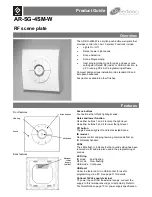NXP Semiconductors
UM10858
PN7462 family HW user manual
UM10858
All information provided in this document is subject to legal disclaimers.
© NXP B.V. 2018. All rights reserved.
User manual
COMPANY PUBLIC
Rev. 1.4 — 14 May 2018
314514
233 of 345
14.1.2 General description
A typical I
²C bus configuration is shown in
. The master device generates all of the
serial clock pulses and the START and STOP conditions. Depending on the state of the
direction bit (R/W), two types of data transfers are possible on the I2C-bus:
•
Data transfer from a master transmitter to a slave receiver. The first byte transmitted
by the master is the slave address. Next follows a number of data bytes. The slave
returns an acknowledge bit after each received byte.
•
Data transfer from a slave transmitter to a master receiver. The first byte (the slave
address) is transmitted by the master. The slave then returns an acknowledge bit.
Next follows the data bytes transmitted by the slave to the master. The master
returns an acknowledge bit after all received bytes other than the last byte. At the
end of the last received byte, a “not acknowledge” is returned.
A transfer is ended with a STOP condition or with a Repeated START condition. Since a
Repeated START condition is also the beginning of the next serial transfer, the I2C bus
will not be released.
Fig 42. I2C bus configuration
The I2C Master can operate in two modes: I2C Master Transmitter and I2C Master
Receiver.


















